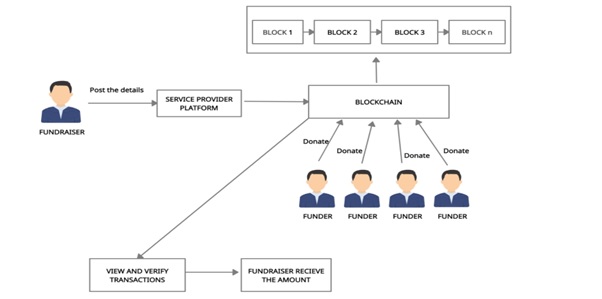Decentralized Crowdfunding Platform Using Blockchain

DOI:
https://doi.org/10.54060/jieee.2023.79Keywords:
Ethereum, Decentralized, Crowd-funding, BlockchainAbstract
Few years back, blockchain was particularly used to support cryptocurrencies, but after some decades, more and more sectors are adopting this brand-new technology. Blockchain will used by the majority of technologies in the future as an effective means of conducting online transactions. Crowdfunding platforms are one of the industries to which blockchain technology may be applied. Although crowdfunding is quite common online, there are still some problems with it. Projects that don't finish on schedule, don't finish at all, or don't provide what they promised cause trust concerns. Additionally, crowdfunding sites serve as intermediaries, so you must put your faith in them to transmit your cash properly. This project solves these problems by integrating Ethereum smart contracts with the crowdfunding platform, scams may be avoided, and it is ensured that projects can be fulfilled within the specified time frame. With the use of blockchain technology, decentralised crowdfunding offers more accessibility, transparency, and reduced fees. The ability to immediately create, watch, and donate to crowdfunding campaigns via the blockchain is the most crucial feature. The decentralised crowdfunding platform is linked to the blockchain and fea-tures authoring solidity code, pairing metamasks, interacting with smart contracts, and sending Ethereum across the network.
Downloads
References
D. Yaga, P. Mell, N. Roby, et al., “Blockchain technology overview,” National Institute of Standards and Technology Gaithersburg, MD, pp.1-68, 2018.
M. C. Lacity, “Blockchain: From Bitcoin to the Internet of value and beyond,” J. Int. Technol., vol. 37, no. 4, pp. 326–340, 2022.
M. M. Nuttah, P. Roma, G. Lo Nigro, et al., “Understanding blockchain applications in Industry 4.0: From information technology to manufacturing and operations management,” J. Ind. Inf. Integr., vol.33, 2023.
Price water house Coopers, “Blockchain, a catalyst for new approaches in insurance: Part 1,” PwC. [Online] https://www https://www.pwc.com/gx/en/industries/financial-services/publications/blockchain-a-catalyst.html
J. Frankenfield, “Satoshi in bitcoin explained: What it is and how much it is worth,” Investopedia, 24-Apr-2017. [Online] https://www.investopedia.com/terms/s/satoshi.asp
K. Sultan, U. Ruhi & R. Lakhani, “Conceptualizing Blockchains: Characteristics & Applications,” vol.1, 2018. https://arxiv.org/abs/1806.03693
A. P. Sari, “Pengaruh Brand Awareness, Kualitas Proyek Dan Kepercayaan Terhadap Keputu Ber-donasi Secara,” Online Pada Platform Crowdfunding Kitabisa Com, 2019.
Melfianora, “Penulisan karya tulis ilmiah dengan studi literatur,” Center for Open Science, May 2019.
C. D. Clack, V. A. Bakshi, and L. Braine, “Smart Contract Templates: foundations,” design landscape and research directions, vol.1, pp. 1–15, 2016. http://arxiv.org/abs/1608.00771.
M. Alharby & A. V. Moorsel, “Blockchain based smart contracts: A systematic mapping study,” in Computer Science & Information Technology, pp.125–140, 2017.
Dictio, “Apa itu crowdfunding,” 2018. https://www.dictio.id/t/apaitu crowdfunding/35242.
T. Branzov & N. Maneva, “Crowdfunding Business Models and Their Use in Software Product Development,” 2015.
A. Thioac, A. Keanu Serut, R. L. Torrejos, et al., “Blockchain-based System Evaluation: The Effectiveness of Blockchain on E-Procurements,” International Journal of Advanced Trends in Computer Science and Engineering, vol. 8, no.5, pp. 2673-2676, 2019.
S. Y. Lee, “Medical Data Framework Using Blockchain Technology,” International Journal of Advanced Trends in Computer Science and Engineering, vol.8, no.5, pp.2353-2358, 2019.
M. Renier, M. Bailon, L. Materum, “International Roaming Services Optimization Using Private Blockchain and Smart Contracts,” International Journal of Advanced Trends in Computer Science and Engineering, vol.8, no.3, pp. 544 - 550, 2019.
A. L. Reibman, and M. Veeraraghawan, “Reliability Modeling: an overview for system design,” IEEE Computer Sociaty, vol.24, no.4, pp.49-57, 1991.
J. L. Lions, ARIANE 5 Flight - 501 Failures Report, 2010.
M. R. Lyu, “Handbook of Software Reliability Engineering,” IEEE Computer Society Press Los Alamitos, California, pp.1-819, 1996.
S. R. Dalal, M. R. Lyu, and C. L. Mallows, “Software Reliability,” John Wiley & Sons, 2014.
R. A. Khan, K. Mustafa, and S. I. Ahson, “Operation Profile-a key Factor for Reliability Estimation,” University Press Gautam Das and V. P. Gulati (Eds), CIT, pp.347-354, 2004.
E. E. Ogheneovo, “Software Dysfunction: Why Do Software Fail,” Journal of Computer and Communications, vol.2, pp.25-35, 2014.
S. W. A. Rizvi, V. K. Singh, R. A. Khan, “Revisiting Software Reliability Engineering with Fuzzy Techniques,” In:IndiaCom Proc. of the 3rd IEEE Int. Conf. on Computing for Sustainable Global Development. Published by IEEExplore, 16-18 March New Delhi, India 2016.
H. B. Yadav & D. K. Yadav, “Early Software Reliability Analysis using Reliability Relevant Software Metrics,” International Journal of System Assurance Engineering and Management, pp.1-12, 2014.
S. W. A. Rizvi, and R. A. Khan, “Maintainability Estimation Model for Object-Oriented Software in Design Phase (MEMOOD),” Journal of Computing, vol.2, no.4, pp.26-32, 2010.
S. W. A. Rizvi, and R. A. Khan, “A Critical Review on Software Maintainability Models,” Proceedings of the Conference on Cutting Edge Computer and Electronics Technologies, vol. pp.144-148, 2009.
H. Pham, “System Software Reliability,” London: Reliability Engineering Series Springer, 2006.
A. K. Pandey & N. K. Goyal, “Early Software Reliability Prediction,” Springer India, 2013.
A. L. Goel, “Software Reliability Models: Assumptions Limitations and Applicability,” IEEE Transaction on Software Engineering, vol.11, no.12, pp.1411-1423, 1985.
H. B. Yadav & D. K. Yadav, “Early Software Reliability Analysis using Reliability Relevant Software Metrics,” International Journal of System Assurance Engineering and Management, pp.1-12, 2014.
L. Zadeh, “Fuzzy Sets Information and Control,” Science Direct, vol. 8, no.3, pp.338-353, 1965.
S. K. Khalsa, “A Fuzzified Approach for the Prediction of Fault Proneness and Defect Density,” In: Proceeding of World Congress on Eng., vol.1, pp.218-223, 2009.
O. P. Yadav, N. Singh, R. B. Chinnam, et al., “A Fuzzy Logic based approach to Reliability Improvement during Product Development,” Reliability Engineering and System Safety, vol.80, no.1, pp.63-74, 2003.
D. Yuan and C. Zhang, “Evaluation Strategy for Software Reliability Based on ANFIS.In: (ICECC-11),” Proceedings of the IEEE International Conference on Electronics and Communications and Control, pp.3738-3741, 2011.
D. K. Yadav, S. K. Charurvedi and R. B. Mishra, “Early Software Defects Prediction using Fuzzy Logic,” International Journal of Performability Engineering, vol.8, no.4, pp.399-408, 2012.
S. Aljahdali, “Development of Software Reliability Growth Models for Industrial Applications Using Fuzzy Logic,” Journal of Computer Science, vol.7, no.10, pp.1574-1580, 2011.
V. Cortellesa, H. Singh and B. Cukic, “Early Reliability Assessment of UML Based Software Models,” In: Proceedings of the 3rd International Workshop on Software and Performance, pp.302–309, 2002.
C. Wholin and P. Runeson, “Defect Content Estimations from Review Data,” In: Proceedings of 20th International Conference on Software Engineering, pp.400-409, 1998.
H. B. Yadav and D. K. Yadav, “A Fuzzy Logic based Approach for Phase-wise Software Defects Prediction using Software Metrics,” Information and Software Technology, vol.63, pp.44-57, 2015.
S. W. A. Rizvi, V. K. Singh, and R. A. Khan, “The State of the Art in Software Reliability Prediction: Software Metrics and Fuzzy Logic Perspective,” Advances in Intelligent Systems and Computing Springer, vol.433, pp. 629-637, 2016.
S. Mohanta, G. Vinod and R. A. Mall, “Technique for Early Prediction of Software Reliability based on Design Metrics,” International Journal of System Assurance Engineering and Management, vol.2, no.4, pp.261-281, 2011.
P. He, B. Li, X. Liu, et al., “An Empirical Study on Software Defect Prediction with a Simplified Metric Set,” Information and Software Technology, vol.59, pp.170-190, 2015.
M. Li and C. Smidts, “A ranking of software engineering measures based on expert opinion,” IEEE Transaction on Software Engineering, vol.29, no.9, pp.811–824, 2003.
N. Martin, N. Fenton and L. Nielson, “Building large-scale Bayesian networks,” The Knowledge Engineering review, vol.15, no.3, pp.257–284, 2000.

Downloads
Published
How to Cite
CITATION COUNT
License
Copyright (c) 2023 Arohi Rathore, Dr. Syed Wajahat Abbas Rizvi

This work is licensed under a Creative Commons Attribution 4.0 International License.

























